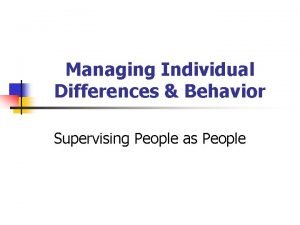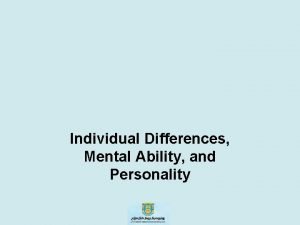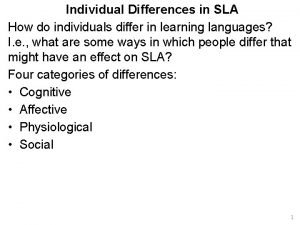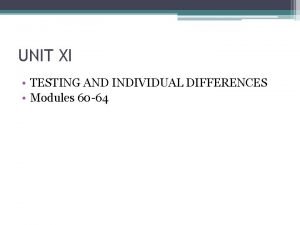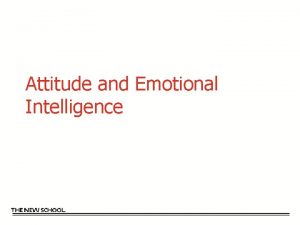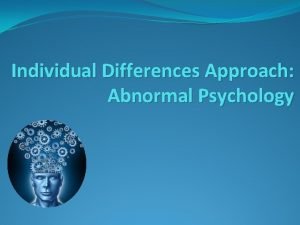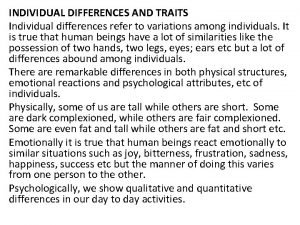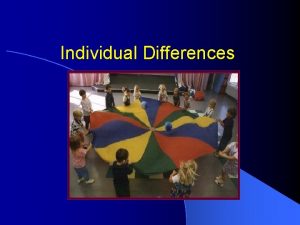Individual assignment Individual Differences in Attitude to School









- Slides: 9

Individual assignment Individual Differences in Attitude to School and Social Reputation By Saidna zulfikar bin tahir 10 B 01003 State university of makassar 2010

CONTENTS BACKGROUND FACTORS RELATED TO BEHAVIOURAL SCHOOL ENVIRONMENT REPUTATION AMONG PEERS ATTITUDE TO SCHOOL AND TEACHERS CONCLUSIONS AND IMPLICATIONS

BACKGROUND Behavioural adjustment problems in schools have lately become a significant concern for teachers, parents, psychologists and society in general, due to the negative consequences these behaviours have for the teaching-learning process, the psychological adjustment of aggressors and victims, as well as quality of social interactions in educational settings (Estévez, Musitu, & Herrero, 2005; Smith & Brain, 2000). Although it is well-known that adolescence is a period of particular risk for involvement in antisocial activities, it is also true that there are significant individual differences in the frequency and stability of such behaviour

FACTORS RELATED TO BEHAVIOURAL Studies examining the link between individual characteristics and behavioural adjustment in adolescence have stressed the role of biological, genetic and organic pathological syndromes, as well as psychological variables such as a tendency to irritability and impulsiveness, low frustration tolerance (Baron & Byne, 1998), general low satisfaction with life (Mac. Donald, Piquero, Valois, & Zullig, 2005), and lack of empathy or the ability to put oneself on another’s place.

SCHOOL ENVIRONMENT The term school environment refers to the social construction of interactions and perceptions that teachers and students develop about the school context (Trickett, Leone, Fink, & Braaten, 1993) and, therefore, it is a reflection of positive or negative feelings about the social climate of the context in which they all interact (Peterson & Skiba, 2000). A positive school environment exists when students feel comfortable, valued and socially accepted in a climate based on support, mutual respect and trust (Moos, 1974). Yoneyama and Rigby (2006) distinguish two principal elements that constitute this positive climate, the first being support and respect from teachers, and the second enjoyment of relationships with peers in the classroom. Moos, Moos and Trickett (1989) also considered these two dimensions, identified by them respectively as teacher support and affiliation among peers; the former refers to the amount of help, trust and attention the teachers offer to students, the latter to the degree of concern and friendship students feel for one another. These authors add a third dimension to define the school environment, namely involvement in school activities, which refers to degree of students’ attentiveness, interest and participation in class activities.

REPUTATION AMONG PEERS Emler and Reicher (1995) propose that some young people may act knowingly to foster a bad reputation. In order to understand the actions of young people so motivated, these authors point out that “it is necessary to appreciate the social framework within which of their actions occur. Two features of this framework are considered in particular; each assumes a special importance in adolescence. Barry (2006) interviewed 40 youths with serious behavioural problems, the majority of them stressing as an important reason to behave antisocially the need “to gain a sense of belonging through identity with friends” (p. 48). According to these authors, the establishment, maintenance and enhancement of a Reputation is essential to all adolescents –especially among peers– and with that purpose, they choose a particular selfpresentation to publicly promote this reputation.

ATTITUDE TO SCHOOL AND TEACHERS In Hirschi’s classic, Causes of Delinquency published in 1969, the author argues that human beings have a natural tendency towards deviance. For this reason he finds it more interesting to ask why people do not deviate. His explanation is that tendency is controlled by the individual’s bonds to society. In particular, Hirschi talks about four elements that reduce antisocial behaviours: (1) attachment to others (e. g. parents and teachers in adolescence), (2) commitment to conformity, (3) involvement in conventional activities, and (4) belief in the moral validity of conventional values and social norms. Moreover, as other authors such as Thornberry and colleagues (1991) have suggested, it seems that there is a temporal causal ordering starting with attachment to parents followed by commitment to and involvement to school, followed in turn by acceptance society’s norms.

CONCLUSIONS AND IMPLICATIONS Both attitude to school context and reputation among peers are related to degree of behavioural adjustment at school. These findings have some relevant practical implications. First of all, it is important to highlight that interventions should not only focus on the particular individuals involved; this would be to overlook relevant contextual factors that need to be taken into consideration to understand mitigate the problem. For instance, numerous programs focused on changing the school and classroom environment as a whole have been proved to be effective in reducing behavioural adjustment problems in adolescence (a wide review can be found in Gottfredson, 2001).

THANK YOU!!!
 Managing individual differences and behavior
Managing individual differences and behavior Proactive personality
Proactive personality Field dependent vs field independent
Field dependent vs field independent Catering for individual differences
Catering for individual differences Individual differences in workplace
Individual differences in workplace Individual differences in workplace
Individual differences in workplace Individual differences factors
Individual differences factors Individual differences in sla
Individual differences in sla Unit xi testing and individual differences
Unit xi testing and individual differences Basic principle of training
Basic principle of training
